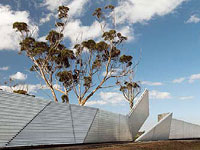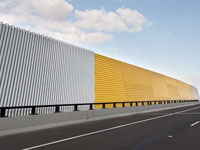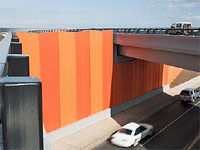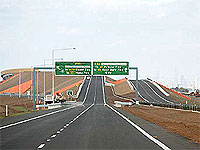Tools & Resources
Vivid Steel Colours Melbourne's Newest Bypass
| Location: | Melbourne |
| Country: | Australia |
| Project Size: | 65,000 Lineal Metres of deeply ribbed steel |
| Architect: | Peter Elliot Architecture + Urban Design |
| Rollformer: | ARM Rollforming |
More than 65,000 lineal metres of deeply ribbed steel noise wall panels are providing a colourful visual identity for Melbourne’s newest major road corridor.
Leading special sections rollforming company, ARM Rollforming, used nearly 800 tonnes of GALVABOND® steel in 2.4mm and 1.55mm thicknesses to manufacture the unique noise barrier panels.
The 9.3 kilometre, four lane Deer Park Bypass in Western Melbourne stretches from the Western Highway at Caroline Springs to the Western Ring Road in Sunshine West, carrying over 70,000 vehicles per day.
Noise walls in vivid colours and galvanised steel, designed by Melbourne practice Peter Elliott Architecture + Urban Design, mark its course as sculptural forms in the landscape.
"The design challenge for the noise barriers was how to make something out of almost nothing, because the road is in a flat landscape," Peter Elliott said.
"We settled on noise walls made from a single material steel in a bold profile, with big flashes of colour to mark the landscape in a quite sculptural way that’s simple and repetitive, but not fussy."
ARM Rollforming used its experience in special sections roll forming to manufacture a profile originally designed for bridge decking to meet the noise wall design requirements.
The 90mm deep trapezoidal profile was selected because of its superior sound attenuation qualities, aesthetic appeal, ease of installation, low maintenance, long life span and cost effectiveness
GALVABOND® steel is a hot-dipped, zinc-coated, deep-drawing steel free from stretcher strain and with a spangled surface resistant to ageing.
Major distributor of sheet and coil products, Sheet Metal Supplies, slit the coil feed steel at its Sunshine, Victoria, premises and coordinated the delivery of the steel to ARM Rollforming’s Dandenong works.
Tight supply constraints were overcome by Sheet Metal Supplies and BlueScope Steel despite design changes during the project which increased the quantity of steel required by nearly 100 tonnes.
Design Innovation
ARM Rollforming’s performance was one of the factors which contributed to the Deer Park Bypass opening in April 2009, eight months ahead of schedule.
"The architects originally found us on the internet," ARM Rollforming Managing Director Henry Wolfcamp said.
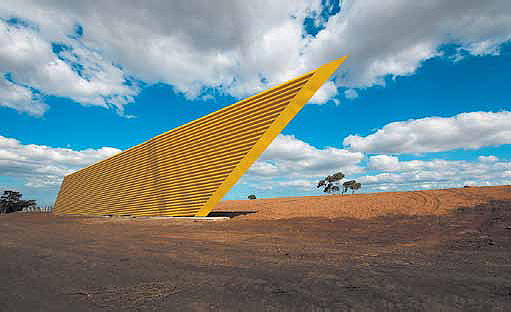
"They wanted a bold profile which was strong enough to withstand the considerable windloads and dense enough to absorb the sound."
"The bridge decking profile we suggested is usually rolled in a 3.5mm thickness, but calculations showed the noise wall performance requirements could be met with just 2.4mm thick GALVABOND® steel."
"Some of the noise wall barrier sections are double sided, especially in residential areas, so they were able to be made with panels rollformed from 1.6mm thick GALVABOND® steel."
"We rollformed the majority of the panels in 12 metre lengths, but some were as long as 16 metres. Each one had to be mitre cut and pre-punched to match the structural members of the noise walls."
Tight dimensional tolerances on the panels were crucial, because their pre-punched fixing holes had to line up with positions on the structural columns.
The panels were delivered to the construction site in sequence and in clearly marked batches to speed erection, with minimal labour and fewer trucks to site than alternative materials would have required.
The panels provided by ARM Rollforming were used to construct a single section of noise wall almost a kilometre long. Even more strikingly they add colour to the abutments of the bridges built to eliminate 20 intersections.
After rollforming by ARM many of the panels were taken to a specialist painting contractor where they were etch primed and then finished in the required colours.
Consistent Quality
Henry Wolfcamp said his company’s involvement in the project spanned more than a year and included intensive roll forming over more than three months.
"With that much roll forming I expected a lot of ‘gal’ build-up on the tooling, but the GALVABOND® steel performed exceptionally well and there were no problems.
"The strength of our relationship with SMS and their backing by BlueScope Steel was crucial," he said. "Once you are tooled up and running you can’t afford to have any problems. There were several suppliers of imported steel keen to get our business, but we weren’t prepared to take any risks on quality."
"Even when changes to the noise wall plans meant that we used two batches of steel there was still a completely consistent spangle pattern across all of the GALVABOND® steel."



